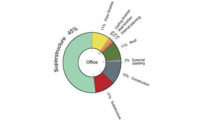The U.S. Environmental Protection Agency estimates that construction materials used for buildings and built infrastructure account for more than 15% of global greenhouse gas emissions. The agency now hopes to boost adoption of materials with lower embodied emissions by offering $160 million in grants to better track and ultimately reduce climate pollution associated with those materials.
The Reducing Embodied Greenhouse Gas Emissions for Construction Materials and Products grants tie into the Biden administration goals of reducing U.S. greenhouse gas emissions 50-52% by 2030 compared to 2005 levels and achieving a net-zero emissions economy by 2050, along with its Buy Clean initiative for federal construction projects, according to Janet McCabe, EPA deputy administrator. The agency selected 38 of the 105 applicants to receive grants, she said on a call with reporters. The grant awards range from $250,000 to $10 million.
“The federal government will set the example here and we’ll support the manufacturing sector as low carbon materials become the norm, not the premium product,” McCabe said.
The grants are supporting efforts to develop environmental product declarations that track environmental impact of a given material, allowing buyers to compare the embodied emissions along with other factors such as price and performance characteristics.
One of the two $10-million grants is going to the National Asphalt Pavement Association. It became a program operator for verified asphalt mixture product declarations in 2014, and then in 2017 created a tool to help asphalt pavement manufacturers develop them, which it has continued to update, according to Audrey Copeland, the group's president and CEO.
In the first few years, it just had 18 asphalt mix plants that published a few dozen product declarations. But now it has more than 300 plants that have published 2,500 of them, Copeland told reporters.
“We’re reaching the point where we’re able to include everything when we’re evaluating materials and products—not only the cost, but also the engineering as well as the environmental impacts,” she said.
With the grant, the association plans to next focus on further improving its product declaration program and incentivizing companies to publish them with rebates, as well as establishing tools for full lifecycle assessment and implementing workforce development programs on asphalt mixture product declarations.
“The whole point of this is to be able to establish a baseline for our industry, where we will know that we are improving year in and year out as we implement these technologies and improve our energy efficiencies and materials,” Copeland said.
Other grantees include a mix of material suppliers such as Heidelberg Materials US Inc. and Holcim U.S. Inc., universities, groups such as the International Code Council and International Living Future Institute, and supplier groups such as Portland Cement Association and National Ready-Mixed Concrete Association. The full list of grant awards is on EPA’s website.
The National Ready-Mixed Concrete Association plans to use its $9.6-million grant on its “Build With Strength” initiative to educate architects and engineers about working with low-carbon concrete. The group has set a goal of increasing the number of concrete producers creating product declarations by 3,000 from the current 1,500 plants.
“This grant is an investment in accelerating our efforts to move the industry toward low carbon concrete solutions,” said Michael Philipps, group president, in a statement.
Work on the various efforts is starting this year, with grantees due to complete their projects by 2029, McCabe said.




